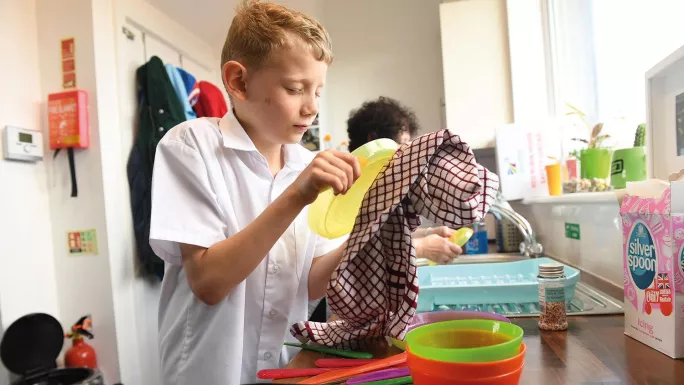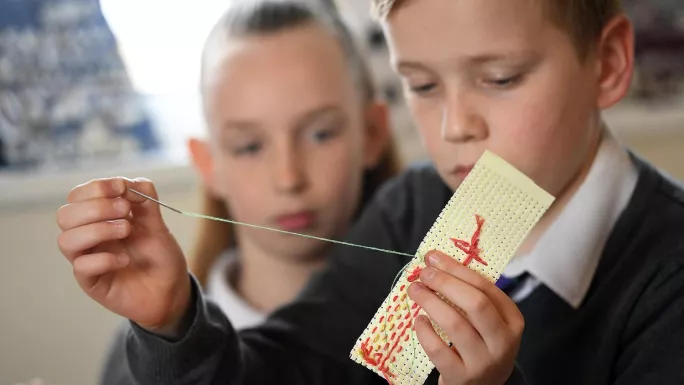Design for life: the model home that’s helping to reshape a community

When the robin was voted Britain’s favourite bird in 2015, not everyone was totally convinced. Philip Hoare, writing in the Guardian, called it “a hooligan bird that puffs up big, throws its weight about [and] jealously guards its patch”.
But then maybe that’s the secret to its success. Sometimes the only way to survive is to punch above your weight. It’s what Vanessa Langley, executive headteacher of Arbourthorne Community Primary School in Sheffield, wants her students to do.
“Arbourthorne isn’t always an easy place to live and welfare cuts have had a significant impact on some of our poorest families,” she explains. “The pastoral staff team estimate that at least 25 out of every 30 families in this area live in relative poverty. We know there are children (at this school) living in homes without books, carpets and basic furniture; residual incomes do not exist. For some children, school is the safest environment they know.”
Langley says we need to accept that coming from this sort of background does have an impact on students. “Children who are living in poverty or challenging circumstances are different,” she argues.
Their journey can be incredibly tough. Poor diet and inadequate living conditions damage life chances, but the draining effect that poverty has on hopes and aspirations is worse. “I want them (the children and families of Arbourthorne) to have the confidence and vision to achieve something better,” she says.
But Langley knows that to do that they need to experience something better. So when the problem of a badly vandalised building (once the school caretaker’s house) came up in conversation with her chair of governors, it became its own solution; a plan was hatched to transform it into a Life Skills Centre.
The centre would be a place for children to learn household skills such as washing up, preparing food, making a bed and vacuuming a carpet. A place for parents to gain the confidence and skills to apply for work or volunteering in the community. But most of all, it would be, in Langley’s words, “a driver of change, where children and adults can learn to create their own futures”.

Finding backers
Although it is a house like any other house on the estate, the overall aim was to turn it into a model of what a family home in this neighbourhood could look like. Making an ideal home out of a vandalised house (in danger of being re-vandalised at the drop of a newly installed kitchen) requires a champion and Langley found one in councillor John Robson. Sadly, Robson died shortly before the building was opened in January 2014. A plaque in his memory reads: “Real generosity towards the future lies in giving all to the present.”
“He was an absolute hero,” says Langley. “It was his passion for this school and this area that helped make it possible, and we named it Red Robin House in his memory.”
Like a modern-day Robin Hood facing town-hall finance officers armed with cold, hard zeal, he fearlessly plundered their funding pots. Banking group HSBC sent staff and money in support. Retailer John Lewis provided goods and services. Other stakeholders pitched in. Then came the final push: a Day of Action, when a vast army of helpers of all ages and abilities completed the transformation.
Three years after it opened, I finally enter Red Robin House. Like all visitors, I replace my outdoor shoes with carpet slippers. I choose pink, fluffy ones to amuse the nurture group that is in the kitchen preparing healthy snacks. Eleven children, with needs ranging from clear boundaries to TLC, sit around the table chopping fruit. Riley - a future MasterChef in the making - has finished and offers to show me around.
His whirlwind tour speeds me out of the well-equipped kitchen, through the lounge full of books, games and cuddly toys (but no TV) and up the stairs.
“Look in here,” says Riley, and before my breath catches up, I’m in the Sensory Room. The space is for children with complex needs (in my experience, most children have complex needs) and for teachers after a hard day. But his demonstration of the room’s mood lighting, projections and bubble pipes is a blur; before I can attain inner peace, we’re on our way again.
Like an estate agent’s video stuck on fast forward, he rushes me into the bathroom with full suite in white including low-flush WC (boys never raise the seat, usually miss the target and always forget to flush, but that’s another issue) and out again. He is desperate to show me his favourite room.
The bedroom has pictures on walls, books on shelves, strategically placed cuddly toys and soft pillows. Riley leaps onto the bed, snuggles down in the Hungry Caterpillar duvet and pretends to snore. It’s easy to forget that there are children who might rarely have slept in a clean, comfortable bed of their own.
The house has a vast array of uses: life skills training, speech and language interventions, joint pupil-parent cooking. A group for students with English as an additional language and their families has recently started using the house with the aim of creating a wider community for some of those parents, building relationships and getting them involved with school.
“We are currently rallying adult volunteers to support the running of even more classes and projects; parents and grandparents of existing and past pupils are keen to spend some of their free time down at the house,” says head of school Kate Ellison.
“They have seen friends and neighbours do the same in the past and want to be a part of it; many previous volunteers have gone on to employment, be that in our school or in their community, due to increased confidence levels and coaching in applying for jobs and interview technique - we’re raising aspirations throughout families.”

Trusting in the community
Red Robin House was a broken building that was fixed by the community with an aim of keeping the mending process alive.
“But there is no magic money bullet to secure the future,” says Langley, not referring solely to the house.
“The fixing has to come from within the community. Our job is to activate creativity and put our trust in that.”
And while creativity is key, success can’t always be measured on a tick list.
“One of the best things we’ve done,” says Ellison, “was when the children took plants they’d grown in the garden and left them on random doorsteps. The responses they got were just so lovely.”
Vanessa smiles. “It’s important to balance the fundamentals with flourishes. People from all walks of life deserve flourishes,” she says.
A Hungry Caterpillar duvet is a flourish of sorts. On the other hand, to flourish means to thrive, and that’s the ultimate aim.
Steve Eddison teaches at Arbourthorne Community Primary School in Sheffield
You need a Tes subscription to read this article
Subscribe now to read this article and get other subscriber-only content:
- Unlimited access to all Tes magazine content
- Exclusive subscriber-only stories
- Award-winning email newsletters
Already a subscriber? Log in
You need a subscription to read this article
Subscribe now to read this article and get other subscriber-only content, including:
- Unlimited access to all Tes magazine content
- Exclusive subscriber-only stories
- Award-winning email newsletters